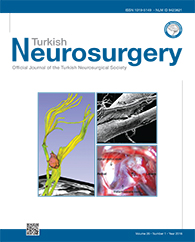MATERIAL and METHODS: The raw data of the Three-dimensional Computerized Tomography Angiography (3D-CTA) were transferred to computer and recorded in a software program.
RESULTS: The study group consisted of 45 (24 female and 21 male) patients. The mean age of the patients was 56±9.5 years. It was found that the entry point of the OphA to the orbital cavity was inferior to the optic foramen in 29 (64.44%) of the cases. The length of the postcanalicular-prelacrimal was 0.54±0.13 centimeters at the right side and 0.51±0.13 centimeters at the left side. The distance of the postlacrimal-presupraorbital segment was 0.43±0.11 centimeters at the right and left sides. The location of the anastomosing site was 0.97± 0.42 centimeters from the supraorbital notch.
CONCLUSION: The results of this study showed us that this technique could be used in the evaluation of the three-dimensional microsurgical anatomy of the OphA and its critical extracranial-intracranial anastomosing site.
Keywords : Ophthalmic artery, Volume rendering, Microsurgical anatomy, Three-dimensional images, Computerized tomography




